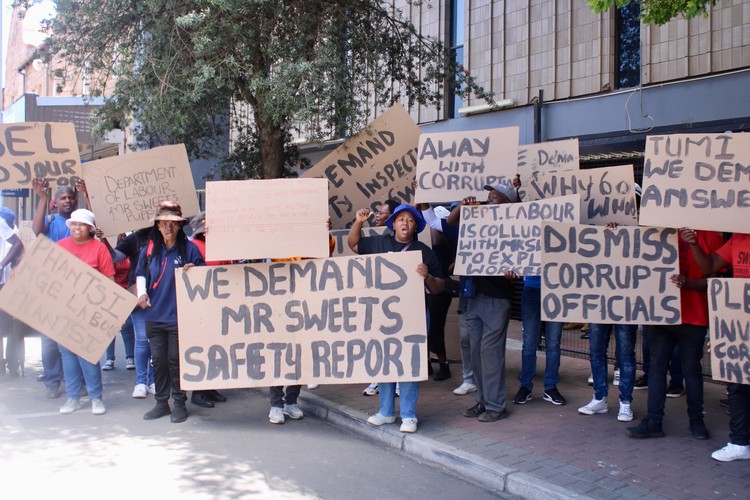More than half of 2024 strikes were unprotected
The number of strikes has been stable over the past few years
Mister Sweet workers picketed outside the Department of Labour’s office in Germiston during their 11-week strike. Archive photo: Kimberly Mutandiro
More than half of all strikes in 2024 were unprotected “wildcat” strikes, according to the latest Strike Barometer report by the Casual Workers’ Advice Office (CWAO).
Unprotected strikes don’t have legal protection and employers can take disciplinary action against workers who take part in them. Wildcat strikes don’t have the support or involvement of a union.
In 2024, the CWAO identified 84 strikes in total. Of these 45 were wildcat strikes.
Strikes by non-unionised workers accounted for the highest number of wildcat strikes, at about 13. These usually involved casual, part-time workers, labour brokers or temporary workers, according to CWAO researcher Sydney Moshoaliba.
About 60% of all the strikes identified by the CWAO were related to wages and benefits. Of the 50 strikes that were wage-related, 24 called for increases. The remaining 26 were for unpaid wages, benefits, or over incorrect pay as per wage agreements.
The second highest number of strikes called for permanent jobs, contract extensions, flexible working conditions and an end to outsourcing.
Other reasons for striking included complaints about workplace health and safety, mismanagement, poor working conditions, and retrenchments. Two strikes involved demands for a union to be recognised and another strike by farmworkers was against evictions.
The longest strike in 2024 lasted about 11 weeks by workers from the Mister Sweet factory. Strikers agreed to the company’s offer of a 6% increase for operators and 5% for general workers in 2025 and 2026. They had initially demanded a wage of at least R19,500 for the highest-paid workers.
The second longest was by South African Municipal Workers’ Union (SAMWU) members against Matjhabeng municipality. They were on strike for ten weeks for salaries that were not paid on time as well as issues related to municipal mismanagement.
The number of strikes per year has remained constant since 2022 and far below the high number of strikes in 2018 with 165 strikes, and 157 in 2019.
“The combined total of 39 strikes in the public sector and privatised public services were led mainly by municipal workers, security guards hired through private companies to guard public institutions, bus drivers, health workers, Presidential Employment Programme workers, Expanded Public Works Programme (EPWP) workers and community health workers,” the report read.
Moshoaliba said that the strike barometer is a good “educational tool” that can be shared amongst workers to show them “similar issues they are facing from different workplaces”.
Support independent journalism
Donate using Payfast

Don't miss out on the latest news
We respect your privacy, and promise we won't spam you.
Next: Protest at medical conference against Israeli speaker
Previous: Deadline to replace SASSA Gold Cards extended to 20 March
© 2025 GroundUp. This article is licensed under a Creative Commons Attribution-NoDerivatives 4.0 International License.
You may republish this article, so long as you credit the authors and GroundUp, and do not change the text. Please include a link back to the original article.
We put an invisible pixel in the article so that we can count traffic to republishers. All analytics tools are solely on our servers. We do not give our logs to any third party. Logs are deleted after two weeks. We do not use any IP address identifying information except to count regional traffic. We are solely interested in counting hits, not tracking users. If you republish, please do not delete the invisible pixel.

